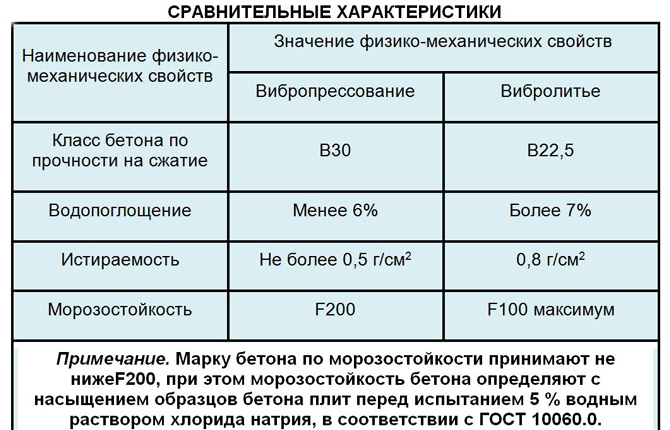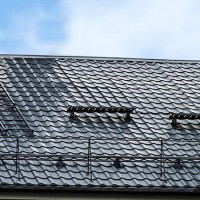Advantages and disadvantages of vibropressed paving slabs
Vibropressed paving slabs are unique in their properties and technical characteristics.It is used to design sidewalks, garden paths, local areas, and streets. The coating is strong, durable, and does not require additional maintenance during operation.
The content of the article:
Vibration casting production method
The vibratory casting method of manufacturing involves filling special forms with concrete or prepared mortar. The process takes place on a vibrating table. The next stages are storage and drying on racks.
Vibropressed production method
The vibropressed manufacturing method involves filling special forms with concrete or prepared mortar. The process takes place on a vibrating table with a vibrating press. With its help, the composition is compacted as much as possible. The next stages are storage and drying on racks.
Tools:
- concrete mixer;
- concrete block press;
- forms;
- composition for filling.
Vibrations and pressing allow the mixture to be evenly distributed among the molds. Filling with compaction takes 3 minutes.
The mixture for paving slabs includes cement, sand, crushed stone (1:1:3), plasticizer (according to instructions). Mix the components in a concrete mixer - this way it turns out faster and without lumps.
The prepared solution is poured into molds on a special vibration-pressed mini-machine so that it is evenly distributed in them and there are no bubbles or voids. Dry them under natural conditions. Vibropressed paving slabs are frost-resistant, durable, with low water absorption and abrasion.
Stages of material production:
- Mixing concrete.
- Preparation of poured forms.
- Pouring and distribution of solution on a vibro-pressed mini-machine.
- The molds take root with the matrix of the vibrating press and the vibration process starts. 3-5 seconds are enough for the material to compact.
- The matrix is raised and the molds are removed from the machine.
- Drying the molds with the material for 2 days under natural conditions.
- Carefully knocking out finished products from molds (if hard, not required for soft ones).
After knocking out, paving slabs are stored in blocks. To allow the mixture to harden and gain strength, store it on pallets for at least 3 weeks. Before transportation to the customer, they are packed in film.
Forms do it on their own, creating bizarre configurations. They are made of rubber, plastic, metal, i.e. materials that can maintain geometry and are not afraid of vibrations.
Advantages and disadvantages
Advantages of vibropressed paving slabs:
- high strength indicators;
- frost resistance;
- the ability to create various configurations;
- ease of repair and installation;
- non-porous, glossy surface.
Flaws:
- the difficulty of selecting exact proportions for the solution;
- high cost of equipment for large-scale production;
- slippery surface.
Vibration-pressed paving slabs have gained popularity due to the low costs of small-scale production. Suitable for laying garden paths and creating individual designs.
Modern production methods
To produce large quantities of vibro-pressed paving slabs, high-tech equipment is used. This is an automated process that includes the following steps:
- The mixture is prepared automatically with precisely calculated proportions of the constituent substances.
- Molding of a strict geometric shape.
- The filling process is controlled by a computer, so the mold cavities are filled evenly.
- The vibropress compacts the mixture, preventing the formation of air cavities and uneven composition in the finished product.
Thanks to the automated process, quality, high levels of frost resistance and strength are achieved. You can choose the final coating option - from rough to glossy. To obtain multi-colored material, the method of two-layer vibro-pressed paving slabs is used.
An important nuance is that the automated production process uses a semi-dry concrete mixture. Under the influence of static and dynamic loads, it is compacted as much as possible.
Advantages of modern production using high-tech equipment:
- high strength indicators;
- automated process;
- ability to choose the color of the finished coating;
- the ability to retrofit equipment without stopping work.
Flaws:
- high prices for equipment;
- high repair costs if a breakdown occurs;
- only primitive geometric shapes of finished products.
The production of vibropressed paving slabs is carried out only by large enterprises that are ready to make significant investments.
Environmental indicators
The environmental friendliness of vibropressed paving slabs is at a high level. The composition contains no harmful substances that, when heated, could enter the environment. There are no allergens, does not contain polymer compounds that pose a danger to human health.
Vibration-pressed paving slabs are a good replacement for ordinary asphalt and rubber coatings. Making its surface rough adds additional benefits to safety when moving on it, especially in rainy weather.
Vibro-pressed or vibro-cast paving slabs?
To determine the appropriate installation option, it is important to understand the purpose of the future coating. Vibro-cast options are used for the garden. They come in unique shapes, and it's not difficult to buy a small batch. Vibropressed tiles are recommended for laying a pedestrian path or garage entrance. They are characterized by high strength and long service life.
In terms of environmental indicators, both options are the same. With active use, vibrocompressed products will last 20 years, and vibrocast products - about 10.
Cast tiles are also produced in shaped shapes, unlike pressed ones. But not always the same size, as it is poured by hand. Bright, original designs are created only by vibration casting.
Paving slabs are an excellent alternative to asphalt and rubber coating. Does not emit harmful substances when heated, looks beautiful. Produced by vibration pressing and vibration casting. The first option is suitable for mass production and installation in places of frequent use. The second one is easy make it yourself or order a batch with a design to suit your taste.
Do you use this building material? Write in the comments. Bookmark the article and share the link on social networks.
We also recommend watching selected videos on our topic.
Vibrocasting or vibrocompression? Where to start producing paving slabs?
Review of raw materials for the production of vibropressed tiles.
Sources:
- https://xn--h1ad5a.xn--90ais/index.php?route=blog/article&blog_post=37
- https://stellard.ru/articles/vibropressovannaya-ili-vibrolitaya-trotuarnaya-plitka-kakaya-luchshe
- https://trotuarnayaplitka.by/stati/trotuarnaya-plitka/kakaya-plitka-luchshe-vibrolitaya-ili-vibropressovannaya









